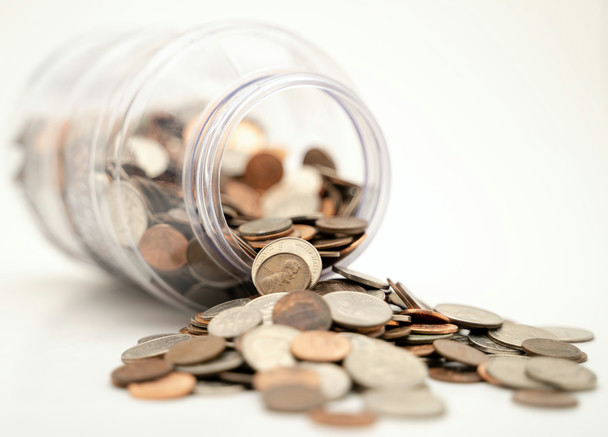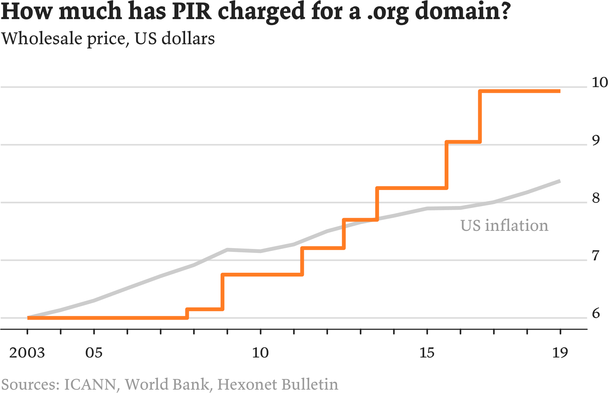Price of .org domains has risen by 3% annually, far below 10% price cap
Blog
The wholesale price of a .org domain could have risen 10% a year since 2003, increasing from $6 then to over $27 now. But in reality the price has risen by an average of only 3% annually. Now price caps have been lifted, what will happen next?

Courtesy Michael Longmire
Controversy reigns over the domain name system. In May this year, ICANN, the body that oversees the Internet’s address system, ignored strong public opinion and removed the rules that kept the wholesale price of .org domains low. Then, a few months later, ICANN stood idly by as Ethos Capital, a private-equity firm, swooped in and bought Public Interest Registry (PIR), the charitable organisation that runs the .org registry.
The full story doesn’t make for comfortable reading. When in January ICANN announced it wanted to remove the price caps on .org domains, which have been in place since 2003, a lot of people disagreed. A lot of people. ICANN received well over 3,000 comments opposing the move. In contrast there were only six in favour. But those six comments must have been very convincing: on the 13th of May ICANN went ahead and removed the price caps anyway. Until that point, PIR could increase their annual fees by at most 10%. Now, there was no limit to their profitability — sorry, charitability. I meant to say charitability.
The new contract was signed in June. Five months later, the Internet Society, the charitable organisation that owns PIR, announced it had sold PIR to Ethos Capital, a private-equity firm with just two employees. Ethos had been established on the 14th of May, the day after ICANN said it would lift the price caps. A domain name, ethoscapital.org, was registered a week earlier by Fadi Chehadé, who until 2016 was the boss of ICANN. The timing was probably just a coincidence.
Chehadé has links to the two employees of Ethos Capital. Eric Brooks, the company’s head, was a colleague of Chehadé’s when they were both at Abry Partners, another private-equity firm. In 2018, Chehadé and Brooks helped Abry buy Donuts, a domain name registry. Donuts was founded by Jonathon Nevett, now the boss of PIR. The current top man at Donuts is Akram Atallah, a childhood friend of Chehadé’s who was temporarily in charge at ICANN before Chehadé took over.
Anyway, I’m sure this is all just your bog-standard, ethical way of doing business, isn’t it? I mean, what do I know? I don’t have an MBA. Just because the Internet Society’s minutes have been redacted to hide their discussion of the sale. Just because there was no competitive bid, or an independent assessment of the value of PIR’s business. Like I say: completely legit1.
In response to the reaction to lifting price caps, ICANN said that their ‘core values do not require it to accede to each request or demand made in public comments’. In case you missed the sub-text, that was PR speak for ‘STFU’. In contrast, PIR, the Internet Society, and Ethos aimed for a more conciliatory tone. On a joint website, keypointsabout.org they said:
The current price of a .org domain name is approximately $10 per year. Our plan is to live within the spirit of historic practice when it comes to pricing, which means, potentially, annual price increases of up to 10 per cent on average — which today would equate to approximately $1 per year.
Annual price increases of ‘approximately $1 per year’ is one way to put it. ‘Prices will double after eight years, triple after twelve, and quadruple after fifteen’ is another. But ignoring that and the weasel words — ‘plan’, ‘spirit’, ‘potentially’, ‘up to’, ‘approximately’ — it made me wonder: exactly what is the ‘historic practice’ of .org pricing?

As it happens, that was surprisingly hard to find out. We know that the wholesale price started at $6.00 in 2003, because it’s in the original contract (section 7.3). And we know it’s $9.93 now because it’s mentioned on the Cloudflare Registrar homepage, among other places. If the original price had increased by 10% every year, the price now would be $27.572. Clearly, the historical practice has definitely not been to increase the price by 10% each year. So what happened between 2003 and 2019?
Well, dear reader, I trawled the Web so you don’t have to. According to its contract with ICANN, PIR must provide at least six months’ notice before increasing the price for .org registrations. Until 2013, ICANN published these announcements on its website (although an increase in 2012 seems to have gone missing). But after that I think PIR announced its price increases privately, to ICANN-accredited registrars only. However, if you look hard enough you can find those registrars announcing the price changes to their customers. After a few hours I’d managed to join the dots.
Over the last almost-seventeen years, there have only been seven price increases. The last was more than three years ago. Now we know that, under PIR’s tenure, .org prices have gone up by an average of 3.2% per year3. This is still above US inflation from 2003–2018, but much lower than ‘10% per year’.
| Date | Price ($) | Increase | Source |
|---|---|---|---|
| 1 Jan 2003 | 6.00 | — | InterNIC, ICANN |
| 18 Oct 2007 | 6.15 | 2.5% | ICANN |
| 9 Nov 2008 | 6.75 | 9.8% | ICANN |
| 1 Apr 2011 | 7.21 | 6.8% | ICANN |
| 1 Jun 2012 | 7.70 | 6.8% | Hexonet |
| 1 Jun 2013 | 8.25 | 7.2% | ICANN |
| 1 Aug 2015 | 9.05 | 9.7% | TheDomains.com |
| 1 Aug 2016 | 9.93 | 9.7% | Hexonet |
Now, I don’t know why a private-equity firm would buy a domain registry shortly after price caps have been removed. But when the new owners say ‘our plan is to live within the spirit of historic practice when it comes to pricing’, I hope they’ve done their research and realise that they’re promising to keep average annual increases at around 3%, and to only increase prices sporadically. We’ll see.
Update, 16 December 2019
On the 9th of December ICANN announced that they have, at least temporarily, withheld their consent to the sale of PIR to Ethos Capital. This doesn’t affect the price caps, however: they were removed in the contract signed in June.
Update, 19 July 2020
In April, ICANN refused to allow Ethos Capital to take control of .org domains. Victory! Since then, former ICANN boss Fadi Chehadé has given up the charade and is now listed as ‘co-CEO’ of Ethos Capital.
If you want to read more about the debacle you can try Sam Klein’s two-part blog post. The Register’s reporting on the story has been good and TechDirt has a nice summary.
You can calculate this using a compound interest formula: $6.00 × 1.1¹⁶. A further increase could have come on 1st January 2020, taking the price to $30.33.
$9.93 ÷ $6.00, raised to the power of 1 ÷ 16. (The increases have taken place over sixteen years.)